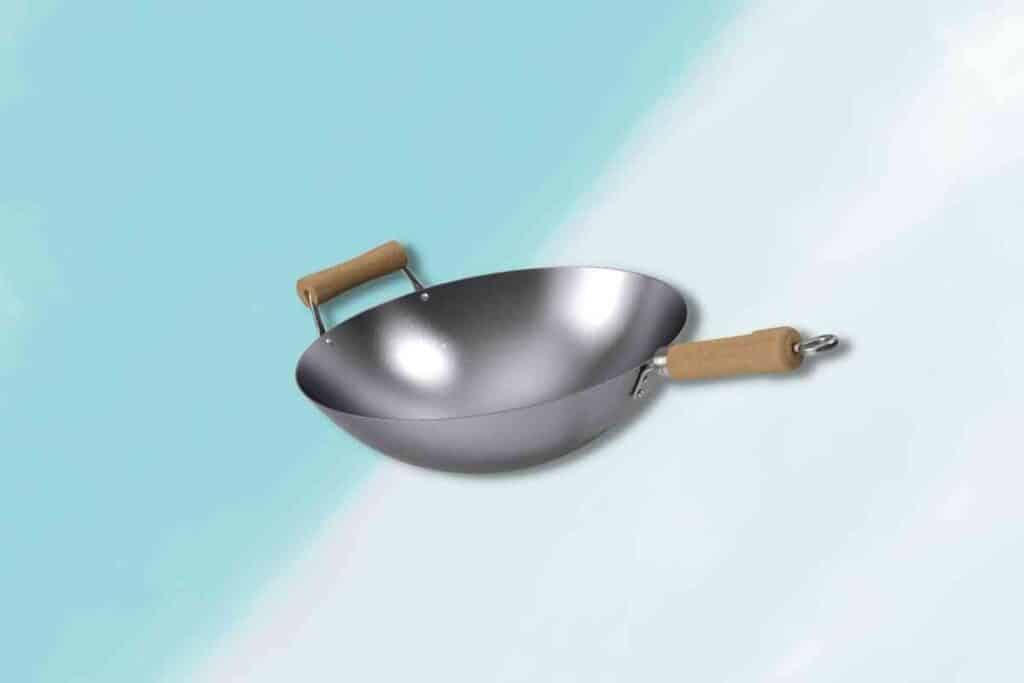Do Stainless Steel Woks Need to Be Seasoned?
Do stainless steel woks need to be seasoned? No, stainless steel woks do not need to be seasoned. Stainless steel is a non-reactive metal, meaning it won’t corrode or rust when it comes into contact with food.
Moreover, stainless steel wok quality varies, and low-quality or cheap woks tend to get rusty and must be seasoned.
Stainless steel is very durable, so your wok is unlikely to develop any scratches or dents over time.
If you want to check out the high-quality Stainless Steel Woks, you can find them here.

However, if you are experiencing food sticks on your stainless steel wok’s surface, you should season it.
In this post, we’ll cover in detail does stainless steel wok need to be seasoned and describe how to season them to make them last longer.
Do stainless steel woks need to be seasoned?
If you are thinking about can you season a stainless steel wok, the simple and best answer is a stainless steel wok does not need to be seasoned.
However, if you want to prevent sticking and make your wok easier to clean, you can season it.
To season a stainless steel wok, heat it on the stove until it is hot. Then, add oil to the wok and swirl it around.
Let the oil smoke for a few minutes, then remove the wok from the heat and let it cool. After it has cooled, you can use it for cooking.
Why Do Woks Need to Be Seasoned?
Seasoning woks is necessary to keep them from sticking. When a wok isn’t seasoned, it becomes too brittle and cracks when heated. Seasoning ensures that the wok’s surface retains heat while remaining reasonably smooth.
How to Season a Stainless Steel Wok?
When using a wok, it is important to season the pan’s surface well before cooking so that food does not stick.
To do this properly, heat your wok over high heat until the metal begins to glow, then add some vegetable or other flavorings.
You should feel the oils seep into the seasoning when you press down on the sides of the pan. Once the oil is fully absorbed, lower the temperature slightly while cooking the food.
The best way to ensure the seasoning is evenly distributed is to use a paper towel. Hold the paper towels in place with a rubber band, then wipe down the entire surface of the wok. Make sure that all areas get wiped as dry as possible.
Then allow cooling for a few minutes. This will ensure that no grease remains on the surface of the wok.
When you are ready to start cooking, fill your wok halfway with water and bring it up to a boil. Place a lid on top of the wok and turn the heat to medium-high.
How to Season a Stainless Steel Wok for the First Time?
To season a stainless steel wok for the first time, you will need to follow these steps:
- Clean the wok thoroughly using warm soapy water and a soft sponge. Dry it completely.
- Heat the wok on medium heat until it is hot.
- Pour a small amount of cooking oil into the wok and use a paper towel or cloth to spread the oil evenly across the surface.
- Continue heating the wok until the oil starts to smoke.
- Turn off the heat and allow the wok to cool completely.
- Repeat the oil application and heating process 2-3 times until a non-stick surface is achieved.
- Store the wok properly to maintain its seasoning.
Using Stove To Season Stainless Steel Wok
Stainless steel wok seasoning: When you season your wok on the stovetop, it helps to protect the metal from heat damage that can occur from the heat generated by high-temperature cooking, such as stir-frying or sautéing.
To season a stainless steel wok on the stove, you should use the following steps.
- Place the wok on the stove over high heat.
- Heat the wok until it is smoking.
- Add one tablespoon of peanut oil to the wok, and swirl the oil around the wok.
- Paper towels or a brush can apply the oil to the entire surface.
- Let the wok sit for about fifteen to twenty minutes to achieve the best results.
- A change in the color of the wok will be evident towards the end, where the bottom of the wok will become darker.
- Let the wok cool entirely after it has been removed from the heat.
After you have seasoned your wok, avoid washing it with water or other harsh chemicals.
Using Oven To Season Stainless Steel Wok
The process of seasoning woks is used to make them non-stick, but it is also very important to season them well in the oven to protect the non-stick surface.
If you don’t season your wok properly, it may get scratched or even damaged in the oven.
To season a stainless steel wok in the oven, you should use the following steps.
- Start by coating the surface of your wok with peanut or groundnut oil.
- Place the wok inside the oven and set the oven temperature to 175 degrees Celsius.
- Leave the wok for at least 3 to 4 hours in the oven.
- During the seasoning process, you should take out the wok every hour and apply oil to its sides.
- Remove wok from the oven and let it cool.
How Often to Season a Stainless Steel Wok?
Stainless steel woks need to be seasoned after every 5 or 6 uses. The purpose of seasoning is to make the cooking surface nonsticky and to enhance the flavor of your meals.
If you are using your stainless steel wok once or twice a month, then seasoning once a month will be fine.
Which oils Are Best for Seasoning Stainless Steel Wok?
Seasoning your stainless steel wok is important to ensure the food tastes good. There are different oils available, but you should choose the one you like.
These are some of the best oils for seasoning a stainless steel wok.
Sesame Oil: This is a great choice because of its flavor and aroma. It’s a popular ingredient in Chinese cuisine and has a light taste that goes well with most foods.
Peanut Oil: It has a slightly nutty smell, so you’ll be able to tell when you put this on your stove. Peanuts have been used in Asian cooking since ancient times, so you know they’ll work well for seasoning.
Olive Oil: If you’re looking to season a stainless steel wok, the best oil to use is olive oil. Olive oil has a high smoke point, so it won’t burn when cooked, and it doesn’t oxidize like other oils.
Flaxseed Oil: Flaxseed oil is used to season stainless steel woks because it doesn’t stick to the surface. Once the wok is seasoned, wipe off the excess oil.
How to Tell If a Wok Is Seasoned?
When heated, a well-seasoned wok should emit no stench. If the stench persists, rinse the wok under running water and repeat the test. If the stink persists, the wok must be re-seasoned.
Woks should be seasoned before being used. Seasoning woks and cooking utensils improve meal flavor by incorporating essential oils.
A dry wok can also be heated at medium-high heat. When the pan begins to smoke slightly, add a few drops of oil and swirl to coat. Add a tiny amount of batter to the heating oil.
Within a minute or so, it should begin to boil and turn brown. Take the pan off the heat and season with salt to taste. The wok should be thoroughly seasoned.
Conclusion
When you plan to season your steel wok, choose a high smoke point oil to season a stainless steel wok. These oils include peanuts and sesame seeds. The higher the smoke point, the better.
You want to avoid cooking with these fats because you don’t want them to burn. It will cause discoloration on the surface.
After heating, rub the surface with a paper towel to clean and then coat it again in a thin layer of oil.
FAQs
What Is the Best Way to Clean a Stainless Steel Wok?
The best way to clean a stainless steel wok is to wipe it down with a paper towel. Then, wash the wok in hot, soapy water. Let it dry completely.
Can I Use My Stainless Steel Wok on Gas or Electric?
You can use your stainless steel wok on gas or electric. However, it will heat differently due to the different heating elements.
Is It Safe to Eat Foods Cooked in a Stainless Steel Wok?
It is safe to eat foods cooked in a stainless steel wok. Stainless steel is an excellent option for cooking, as there’s no need to worry about the wok leaching any metals into your food.
How to Season Stainless Steel Wok
To season a stainless steel wok, start by heating it over medium heat, adding a high smoke point oil like grapeseed or vegetable oil, spreading it evenly, and heating until it smokes. Then, let it cool, wipe off excess oil, and repeat this process several times until the wok develops a non-stick patina.
Do You Need to Season a Stainless Steel Wok
Yes, seasoning a stainless steel wok is recommended to improve its non-stick properties and prevent food from sticking.
Do You Need to Season Stainless Steel Wok
Yes, seasoning a stainless steel wok is important to create a non-stick surface and enhance its cooking performance.
How to Use Stainless Steel Wok
When using a stainless steel wok, preheat it, add oil, and stir-fry ingredients. Frequent stirring and proper heat control are key to prevent sticking.
How to Use a Stainless Steel Wok
Using a stainless steel wok involves preheating it, adding oil, and stir-frying ingredients while maintaining constant movement to prevent sticking.
Do You Season a Stainless Steel Wok
Yes, seasoning a stainless steel wok is necessary to make it non-stick and enhance its cooking capabilities.
Curing Wok Stainless Steel
“Curing” a stainless steel wok is another term for seasoning it, which involves applying and heating oil to create a non-stick surface.
Are Stainless Steel Woks Any Good
Stainless steel woks can be good for certain types of cooking, offering durability and even heat distribution, but they often require seasoning to perform well for stir-frying.
Can You Season Stainless Steel Wok
Yes, you can season a stainless steel wok to improve its non-stick properties and make it better suited for stir-frying and other cooking methods.
How to Prevent Stainless Steel Wok from Sticking?
To prevent food from sticking to a stainless steel wok, you can follow these steps:
- Heat the wok over high heat until it is hot before adding oil.
- Add a small amount of oil to the wok and swirl it around to evenly coat the surface.
- Add food to the wok and stir-fry it quickly over high heat, constantly stirring and tossing the food.
- Keep the food moving so it doesn’t have a chance to stick to the wok.
- If necessary, add a little more oil to prevent sticking.
How to Season a Wok
To season a wok, heat it, add oil, and spread the oil evenly while heating until it smokes. Allow it to cool, wipe off excess oil, and repeat the process several times to develop a non-stick patina.
Why Wok Needs to Be Seasoned
A wok needs to be seasoned to create a non-stick surface, prevent rust, and enhance its cooking performance, especially for stir-frying.
Are Stainless Steel Woks Good
Stainless steel woks can be good for certain types of cooking due to their durability and even heat distribution, but they often require seasoning to perform well for stir-frying.
Does Stainless Steel Need to Be Seasoned
Stainless steel typically does not need seasoning for its non-stick properties. However, seasoning can be done for specific purposes, such as enhancing wok performance.
Do All Woks Need to Be Seasoned
Not all woks need to be seasoned. Carbon steel and cast iron woks benefit from seasoning to create a non-stick surface, while stainless steel woks may or may not be seasoned, depending on preference.
Why Do You Need to Season a Wok
Seasoning a wok is necessary to create a non-stick surface, prevent rust, and improve its cooking performance.
Wok with TAK Seasoning
“Wok with TAK seasoning” likely refers to a wok that has already been seasoned with oil. TAK seasoning may be a specific technique or brand-related term.
Why Does a Wok Need to Be Seasoned
A wok needs to be seasoned to develop a non-stick surface, enhance heat distribution, and improve its cooking efficiency.
Is a Stainless Steel Wok Good
Stainless steel woks can be good for certain cooking tasks due to their durability and heat distribution. However, they may require seasoning for stir-frying.
Stainless Steel Wok Care
Caring for a stainless steel wok involves regular cleaning, avoiding harsh detergents, and possibly seasoning it to maintain its non-stick properties.
Why Should You Season a Wok
You should season a wok to create a non-stick surface, improve cooking results, and prevent rust or corrosion.
Does Stainless Steel Need Seasoning
Stainless steel generally doesn’t require seasoning for non-stick properties. However, seasoning can be applied for specific cooking preferences.
Spot Seasoning Wok
Spot seasoning involves applying and heating oil to specific areas of a wok that may need additional seasoning, such as areas where food sticks.
Does a Stainless Steel Pan Need to Be Seasoned
Stainless steel pans do not necessarily need to be seasoned for non-stick properties, but it can be done to enhance performance for certain tasks.
Does a Wok Need to Be Seasoned
Many woks, particularly carbon steel and cast iron ones, benefit from seasoning to create a non-stick surface and improve cooking results.
Can You Use Metal on Wok
You can use metal utensils on a wok, but it’s best to use wooden or bamboo utensils to avoid scratching the wok’s seasoning.
How to Clean Wok Bottom
To clean a wok bottom, scrub it gently with a soft brush or sponge, avoiding abrasive materials that may damage the seasoning. Rinse and dry thoroughly.
How to Season a Carbon Steel Wok for the First Time
To season a carbon steel wok for the first time, heat it, add oil, and spread the oil evenly while heating until it smokes. Repeat this process several times to develop a non-stick patina.
Is Stainless Steel Wok Safe
Stainless steel woks are generally safe for cooking, as they do not react with food and are resistant to rust. However, proper seasoning and care are important for optimal performance.
Purpose of Seasoning a Wok
The purpose of seasoning a wok is to create a non-stick surface, improve heat distribution, and enhance its cooking capabilities.
Why Do We Need to Season a Wok
Seasoning a wok is necessary to prevent food from sticking, enhance its cooking performance, and protect it from rust and corrosion.
Why Do You Season Wok
Seasoning a wok is done to develop a non-stick surface, improve cooking results, and maintain the wok’s longevity by preventing rust and corrosion.





